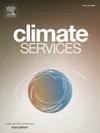Ordered probit results of determinants of climate change vulnerability across different agricultural enterprises in Kenya
IF 4
3区 环境科学与生态学
Q2 ENVIRONMENTAL SCIENCES
引用次数: 0
Abstract
Climate change is significantly impacting small-scale farmers in Kenya, particularly those engaged in key agricultural enterprises; crop cultivation, livestock farming, and fish production. To design interventions and develop policies to address the challenges posed by climate change, it is important to gather evidence of the extent of household vulnerability and the related factors. This study assessed household vulnerability to climate change and identify contributing factors to guide effective interventions and policies. Using the Livelihood Vulnerability Index and ordered Probit regression model, data from 723 small-scale farmers were analyzed. The findings show that households relying solely on crop farming are more vulnerable to the effects of climate change than those combining two or more types of agricultural activities. Households that engaged in multiple farming enterprises such as mixing crops with livestock or fish farming were better prepared to cope with climate-related challenges. Additionally, households headed by younger or more educated individuals, with access to agricultural training and extension services, accessing credit, having membership in farming groups, and located closer to markets were generally less vulnerable. Based on these findings, the study recommends i) implementation of interventions that promote multi-enterprise farming and synergies to enable farmers to diversify risks, (ii) introducing affordable credit options for farmer households, facilitated through policy and other initiatives such as cooperatives, as means to reduce household vulnerability to climate change, and (iii) strengthening government meteorological and extension services to ensure timely and efficient dissemination of climate change-related information to farmers, facilitating the adoption of adaptation measures.
肯尼亚不同农业企业气候变化脆弱性决定因素的有序概率结果
气候变化正在严重影响肯尼亚的小农,特别是那些从事主要农业企业的小农;种植业、畜牧业和渔业。为了设计干预措施和制定政策以应对气候变化带来的挑战,收集有关家庭脆弱性程度和相关因素的证据非常重要。本研究评估了家庭对气候变化的脆弱性,并确定了影响因素,以指导有效的干预措施和政策。利用生计脆弱性指数和有序Probit回归模型,对723名小农的数据进行了分析。研究结果表明,仅仅依靠农作物种植的家庭比结合两种或两种以上农业活动的家庭更容易受到气候变化的影响。从事多种农业企业的家庭,如将作物与牲畜或鱼类混合养殖的家庭,能够更好地应对与气候有关的挑战。此外,户主较年轻或受教育程度较高的个人,能够获得农业培训和推广服务,获得信贷,是农业团体的成员,并且离市场更近的家庭通常不那么脆弱。根据这些发现,该研究建议:(1)实施促进多企业农业和协同效应的干预措施,使农民能够分散风险;(2)通过政策和合作社等其他举措为农户提供负担得起的信贷选择,作为减少家庭对气候变化脆弱性的手段;(三)加强政府气象和推广服务,确保及时有效地向农民传播与气候变化有关的信息,促进采取适应措施。
本文章由计算机程序翻译,如有差异,请以英文原文为准。
求助全文
约1分钟内获得全文
求助全文
来源期刊

Climate Services
Multiple-
CiteScore
5.30
自引率
15.60%
发文量
62
期刊介绍:
The journal Climate Services publishes research with a focus on science-based and user-specific climate information underpinning climate services, ultimately to assist society to adapt to climate change. Climate Services brings science and practice closer together. The journal addresses both researchers in the field of climate service research, and stakeholders and practitioners interested in or already applying climate services. It serves as a means of communication, dialogue and exchange between researchers and stakeholders. Climate services pioneers novel research areas that directly refer to how climate information can be applied in methodologies and tools for adaptation to climate change. It publishes best practice examples, case studies as well as theories, methods and data analysis with a clear connection to climate services. The focus of the published work is often multi-disciplinary, case-specific, tailored to specific sectors and strongly application-oriented. To offer a suitable outlet for such studies, Climate Services journal introduced a new section in the research article type. The research article contains a classical scientific part as well as a section with easily understandable practical implications for policy makers and practitioners. The journal''s focus is on the use and usability of climate information for adaptation purposes underpinning climate services.
 求助内容:
求助内容: 应助结果提醒方式:
应助结果提醒方式:


